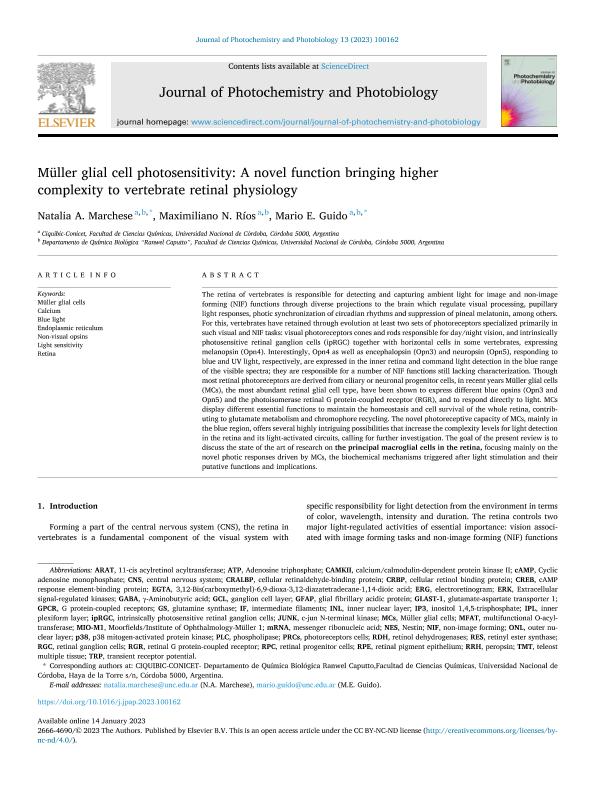Artículo
Müller glial cell photosensitivity: A novel function bringing higher complexity to vertebrate retinal physiology
Fecha de publicación:
02/2023
Editorial:
Elsevier
Revista:
Journal of Photochemistry and Photobiology
ISSN:
2666-4690
Idioma:
Inglés
Tipo de recurso:
Artículo publicado
Clasificación temática:
Resumen
The retina of vertebrates is responsible for detecting and capturing ambient light for image and non-image forming (NIF) functions through diverse projections to the brain which regulate visual processing, pupillary light responses, photic synchronization of circadian rhythms and suppression of pineal melatonin, among others. For this, vertebrates have retained through evolution at least two sets of photoreceptors specialized primarily in such visual and NIF tasks: visual photoreceptors cones and rods responsible for day/night vision, and intrinsically photosensitive retinal ganglion cells (ipRGC) together with horizontal cells in some vertebrates, expressing melanopsin (Opn4). Interestingly, Opn4 as well as encephalopsin (Opn3) and neuropsin (Opn5), responding to blue and UV light, respectively, are expressed in the inner retina and command light detection in the blue range of the visible spectra; they are responsible for a number of NIF functions still lacking characterization. Though most retinal photoreceptors are derived from ciliary or neuronal progenitor cells, in recent years Müller glial cells (MCs), the most abundant retinal glial cell type, have been shown to express different blue opsins (Opn3 and Opn5) and the photoisomerase retinal G protein-coupled receptor (RGR), and to respond directly to light. MCs display different essential functions to maintain the homeostasis and cell survival of the whole retina, contributing to glutamate metabolism and chromophore recycling. The novel photoreceptive capacity of MCs, mainly in the blue region, offers several highly intriguing possibilities that increase the complexity levels for light detection in the retina and its light-activated circuits, calling for further investigation. The goal of the present review is to discuss the state of the art of research on the principal macroglial cells in the retina, focusing mainly on the novel photic responses driven by MCs, the biochemical mechanisms triggered after light stimulation and their putative functions and implications.
Archivos asociados
Licencia
Identificadores
Colecciones
Articulos(CIQUIBIC)
Articulos de CENTRO DE INVEST.EN QCA.BIOL.DE CORDOBA (P)
Articulos de CENTRO DE INVEST.EN QCA.BIOL.DE CORDOBA (P)
Citación
Marchese, Natalia Andrea; Rios, Maximiliano Nicolas; Guido, Mario Eduardo; Müller glial cell photosensitivity: A novel function bringing higher complexity to vertebrate retinal physiology; Elsevier; Journal of Photochemistry and Photobiology; 13; 2-2023; 1-11
Compartir
Altmétricas




